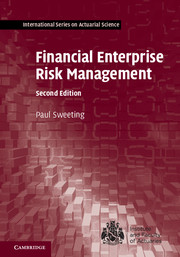Book contents
- Frontmatter
- Contents
- Preface
- 1 An Introduction to Enterprise Risk Management
- 2 Types of Financial Institution
- 3 Stakeholders
- 4 The Internal Environment
- 5 The External Environment
- 6 Process Overview
- 7 Definitions of Risk
- 8 Risk Identification
- 9 Some Useful Statistics
- 10 Statistical Distributions
- 11 Modelling Techniques
- 12 Extreme Value Theory
- 13 Modelling Time Series
- 14 Quantifying Particular Risks
- 15 Risk Assessment
- 16 Responses to Risk
- 17 Continuous Considerations
- 18 Economic Capital
- 19 Risk Frameworks
- 20 Case Studies
- 21 Solutions to Questions
- References
- Index
15 - Risk Assessment
Published online by Cambridge University Press: 12 August 2017
- Frontmatter
- Contents
- Preface
- 1 An Introduction to Enterprise Risk Management
- 2 Types of Financial Institution
- 3 Stakeholders
- 4 The Internal Environment
- 5 The External Environment
- 6 Process Overview
- 7 Definitions of Risk
- 8 Risk Identification
- 9 Some Useful Statistics
- 10 Statistical Distributions
- 11 Modelling Techniques
- 12 Extreme Value Theory
- 13 Modelling Time Series
- 14 Quantifying Particular Risks
- 15 Risk Assessment
- 16 Responses to Risk
- 17 Continuous Considerations
- 18 Economic Capital
- 19 Risk Frameworks
- 20 Case Studies
- 21 Solutions to Questions
- References
- Index
Summary
Introduction
Once risks have been analysed, the results must be assessed. This is true whether considering a project to be initiated, a product to be launched or an asset allocation to be adopted. Such analysis will generally involve trying to maximise (or minimise) one variable subject to a maximum (or minimum) permissible level of another variable.
Creating these variables will often involve applying particular risk and return measures to particular items. The different types of measures are described below, and choosing the appropriate one involves careful consideration.
The item to which risk and return measures are applied also requires some thought. These might be income or capital measures, and they might be prospective or retrospective. Income measures might be profit or earnings related, but cash flow might also be important, as liquidity problems can result in the closure of otherwise-profitable firms. Capital measures might relate to the share price of a firm, or the relationship between some other measure of assets and liabilities.
As well as determining the measures of risk and return to be used, and the items to which they should be applied, the level of risk that can be tolerated must be determined. This means visiting the concept of risk appetite. However, it is also important that risk appetite is placed in the context of other risk-related terminology.
There are many different classifications in this regard, and the terminology here is not intended to be definitive. However, it is intended to be unambiguous and to give an idea of the range of considerations an organisation will have in respect of risk.
Risk Appetite
Once an organisation has identified, described and, where appropriate, quantified all of the risks to which it is exposed, the resulting summary is known as its risk profile. This is an assessment of the risk that an organisation is currently taking.
However, for this to be useful, it needs to be compared with the organisation's risk appetite. This is itself a combination of two things: risk tolerance and risk capacity.
Risk Tolerance
Risk tolerance is a cultural issue, part of the organisation's internal risk management context, and is about the subjective decision a firm has taken on where it would like to be in the risk spectrum. Different stakeholders may well have different risk tolerances.
- Type
- Chapter
- Information
- Financial Enterprise Risk Management , pp. 397 - 428Publisher: Cambridge University PressPrint publication year: 2017

